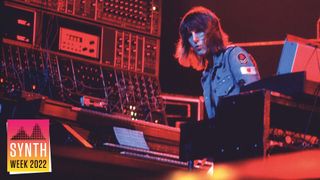SYNTH WEEK 2022: The 70s is the decade when this new musical synth technology began to really find its feet. Granted, it was still an incredibly expensive preoccupation, but synthesiser development continued with the American companies leading the charge, while new horizons appeared from the east.
Alan Robert Pearlman was a designer, electrical engineer and inventor, who spent five years working at NASA. In 1969 he founded his own company, formed from the initials in his name. ARP instruments Inc, (originally branded as Tonus Inc.) were to become a major player in the synthetic arena, beginning on the dot of 1970 with the release of the ARP 2500. Like many of its predecessors, the 2500 was another modular behemoth.
Many people regarded it as being a rather overwhelming instrument to use, being confronted by a multitude of modules, ranging from oscillators, filters, LFOs and VCAs, to a dedicated sequencer and keyboard. You certainly got a lot of sound creation potential for your money, which was just as well because the synthesiser cost £5400 for what was deemed to be a standard configuration.
The role of ARP in the development of synthesis is of great importance, as it provided a very different colour palette to that being created by Moog. Some aficionados actually went further, commenting that the ARP oscillators were far more stable at holding pitch. Harsh words, but forgotten pretty quickly in the same year, when Moog released the synthesiser that would go on to become the most revered and coveted machine of them all; The Minimoog.
Take the mini for a spin
There was an awful lot to shout about. Firstly, the Mini adopted a form that made it truly engaging. Its panel and fascia could be propped up at an angle, which invited the user to get creative with sound, with a 37-note keyboard for instant playability. Unlike just about all predecessors, the Minimoog was not modular, or even semi-modular, meaning that patch cables were not required. It hosted three incredible-sounding oscillators, all routed in the direction of the now legendary Moog 24dB/4-pole low-pass ladder filter.

Users often described its power, which for the first time offered something to keyboard players that could truly compete with the guitarist in the band! Then there was the price; at just over £600, it was still very expensive, but relatively affordable if compared to anything else on the market, and that made it a prospect for many keyboard players to place on top of their Fender Rhodes electric pianos. It is worth noting that the Mk1 Fender Rhodes had a curved top, leading to the spectacle of many Minimoogs being gaffer taped, to prevent them from moving around, while being played.
Meanwhile, in 1971 yet another legendary machine appeared from the ARP stable, in the form of the semi-modular ARP 2600. It was smaller and more portable than the 2500, but still offered three oscillators for a monophonic voice, in a more versatile routing architecture. It underwent numerous revisions, over a tenure that lasted ten years, while being regarded as one of the absolute greats.
Enter the Brits
Not to be outdone, the Brits got in on the action the following year, with the introduction of the EMS Synthi 100. Unlike the Minimoog, this was another behemoth of a synthesiser, mustering an enormous 12 voltage-controlled oscillators, two noise generators, three ring modulators, and four low-pass and high-pass filters. It was also very large, and very heavy, with an initial cost of £6500.
While the Americans and British were having all of the fun, change was afoot, and it came from all of the way over in Japan. In 1972, a new company called Roland Corp. appeared, with the very first product in the shape of a drum machine. It was styled to include a music stand made of wood, the concept being that you could place it on top of your home organ or piano, and provide a drum-box accompaniment for your ivory-based noodlings.
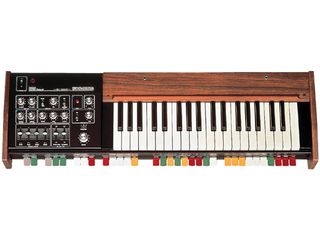
But it was in 1973 that Roland produced their first synthesiser; the SH-1000. It hosted a set of rocker switches across the front, labelled with instrumentation such as tuba, trumpet and harpsichord, operating in a monophonic capacity. By today’s sonic standards, it was all very limited indeed, but it has gone on to be described as something of a design classic, being particularly popular with the vintage-retro enthusiasts out there.
Still in 1973, the Yamaha Corporation decided to enter the fray, with the incredibly large and organistic stylings of the GX-1. Also described as the dream machine, it became an enormous hit with artists such as Keith Emerson and Stevie Wonder, with Stevie using it as a mainstay of his classic album Songs in the Key of Life.
A hat-trick from Japan
Around this same time, in Japan, a little known company called Korg had been beavering away with drums machines, but decided to enter the synth market with a machine that was often described as the most affordable of synths. The MiniKorg 700 was both modest and basic, but thanks to its relatively cost-effective production, it also provided a half-decent entry point to electronic music for many musicians who lacked serious funds.
Back in America, it was beginning to feel as though competition was hotting up. 1975 saw the release of the Moog Polymoog; a 71-key velocity-sensitive synthesiser, which was more of a performance tool, thanks to its ability to zone its keyboard with different voices. It was in the same year that another industry type, who had been interested in synthesisers for some years, released his own take on polyphonic synthesis. Tom Oberheim had been working on a module called the Synthesiser Expander Module, or SEM for short. While overtly monophonic, Oberheim placed four of them in a keyboard housing to create the Oberheim 4-voice.

In the same year, Roland announced a modular system of sorts, which was known as the System 100; the concept was slightly different to that of the Moog modular, offering modules that were larger in scale, forming complete voice signal paths. There were four modules, the first two being synth voices, one with a keyboard and one without, while the other two modules comprised a mixer and a sequencer. By today’s standards, it’s a little like happy families, with complete vintage systems demanding exceptional price tags.
Once patched altogether, it was a powerful Japanese sound, that formed that backbone for much of the early output from bands such as the Human League. You could even finish the system off with a stereo pair of speakers, designed to provide an all-in-one solution. The system was given a major overhaul a few years later, leading to the appearance of the fully modular Roland System 100m in 1979, offering greater flexibility and expanded module options.
Strings and vocoders
The biggest problem with the developing technologies of the 70s, was that the costs involved could be prohibitively expensive for many to enjoy the wonders of true synthesis.
Many keyboard players from this era found themselves to be reliant on the legendary Fender Rhodes electric piano which, apart from offering a different sound colour to a traditional piano, also offered amplification options and true polyphony. The same could not be said for synthesisers, even the really expensive ones, that might only offer a handful of notes. Hence, some manufacturers responded by producing a type of keyboard which would be described as a String Machine.
By association with ARP, the Solina String Ensemble (1974) was one of the better known machines, offering pad and string-like tones, which could also operate with virtually unlimited polyphony. Many of these machines have gone on to acquire classic status, with many bands and producers using them in a contemporary setting.

The Roland RS-505 (1978) is another fine example, but Roland surpassed themselves in 1979 by combining the string machine with vocoder technology, to produce the VP-330 Mk1 Vocoder Plus. In actual fact, the VP-330 could play a number of sounds simultaneously, in layers, which included the vocoder element, strings, brass and even synthetic choirs.
Vocoding technology was nothing new at this stage, but the Roland did offer an easily accessible way of working polyphonically, with both string and vocoder elements. The vocoder patching was entirely preset, not allowing for much experimentation, but it did work consistently well, and in line with many other machines of this era, has become regarded as a vintage classic.
The legend that is
In 1977 though, Yamaha released a synth which would become one of the synth heavyweights of the era, literally. The CS-80 was released in 1977, weighing a stupendous 250lbs. It cleverly provided four memories among the presets, accessed via a small panel which, when lifted, exposed all of the synth’s control faders in miniature. There were even rumours of musicians needing to have their floors reinforced to cope. Just ask Vangelis, who of course made the CS-80 one of the central components for his soundtrack to the Ridley Scott film Blade Runner.
The one point that all of the synths had in common, up until this mid-70s point, was their association with analogue electronics, moreover discrete electronics. This relied upon larger and heavier components, reflected in the machines themselves. They’d often be heavy, sometimes to the point of unmanageable. Fast forward to 1978 and a landmark event occurred with chip technology that maintained the analogue credentials but added more methods of control for programmability and storage in a memory.
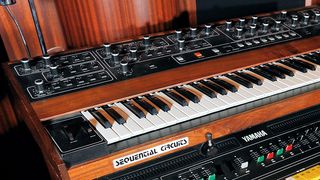
Dave Smith founded his company called Sequential Circuits in 1974. As suggested by the branding, Dave spent his earlier years designing and producing sequencers. But it was in 1978 that Sequential announced the production of the world’s first programmable synthesiser.
The Prophet-5 became the must-have synthesiser; bedecked with a five-octave keyboard, and performance wheels, the five-note polyphonic synthesiser allowed patch creation and capture, within its embedded microprocessor-based memory. It wasn’t cheap, at a release cost of £3500, but at this particular time in music technology history, it was thought of as a synthesiser that could do everything. OK, it lacked the grunt of the Minimoog, but it sounded rich and creamy, in part thanks to its Curtis-based 24dB/4-pole filter.
They might be giants, but...
Many of the names we have mentioned thus far will doubtless be incredibly familiar, as the brands have become enshrined in the annals of history relating to synthesiser production.
Among the legacy of the giants, we have to give mention to some of the smaller companies, and one that might be recognisable for contemporary reasons. Steiner-Parker was a company started by Nyle Steiner, a trumpeter and synthesist who worked on feature films such as Apocalypse Now, and Dick Parker.
Their most famous product was a lesser known synthesiser called an Electronic Valve Instrument, akin to an electronic trumpet. In actual fact, it didn’t really function like a trumpet at all, and it had its fans, but rather lost out to the rise of its wind instrument counterpart, known as the EWI.

If you are thinking that the name feels familiar, this may be because you own an Arturia synthesiser. Arturia employ the infamous Steiner-Parker filter on many of their own synths. Steiner-Parker also produced hardware synthesisers back in the mid 70s, such as the very impressive and now highly collectible Synthacon. A relatively impressive mono synth, with obvious Moog influences.
Japan were far from oblivious to the success of the Prophet-5, and in something of a synth war, released the Jupiter 4 in 1978. This was deemed more affordable than the Sequential and Moog counterparts, and was the first appearance of the now legendary Jupiter product name. A four-voice synth, the Jupiter garnered a new Roland element of control known as Compuphonic. This placed the VCOs under microchip control, stabilising tuning, while eight memories meant saving of patches.
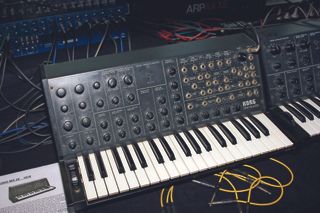
Korg also continued their development of synths, with the similarly classic MS-20 monosynth appearing in 1978. It offered an intriguing semi-modular design, with a patchbay which continues to confuse most who decided to explore it, but importantly the MS-20 used both low and high-pass filtering, which was beautifully aggressive, if you wanted it to be. Once resonating, it could rip your head off!
As the sun set on the 70s, even more reliable technologies were emerging, setting the perfect scene for the decade to follow, when synths would rule the charts…
Synth's Top 10 of the '70s
1. The Minimoog
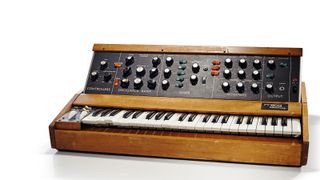
It’s the synth that arguably set the bar for all synths that followed; the stylish concept and framework laid down by Bob Moog in this 37-note, monophonic classic, gave a vaguely affordable option for keyboard players, that could compete sonically with the loudest guitarist in the band! As much in demand today as it was a full 50 years ago.
2. Chick Corea
The extraordinary jazz pianist and keyboardist Chick Corea was a leading light in the jazz and fusion scene, using multiple keyboards in his rig, which included Yamaha’s and, of course, the Minimoog. While one of his later albums, The Mad Hatter utilised the Mini’s features in a highly orchestrated setting, he was possibly better known for his work in the early 70s with his all-star band, Return to Forever – musically complicated but sonically out of this world.
3. The ARP 2600 and R2D2
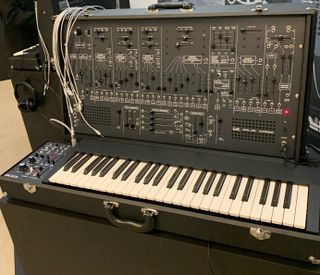
In 1977, we caught the first glimpse of a film franchise which is still very much in progress today. Star Wars Episode IV - A New Hope was the first of the franchise to make it to celluloid, thanks to director George Lucas. The actors were accompanied by two ‘droids’; C3PO was upright and humanistic, while R2D2 was short and had a voice that was a generated series of bleeps and slides from an ARP 2600.
4. Keith Emerson - Emerson, Lake and Palmer
No band better demonstrates the prog-rock era than ELP; technically gifted keyboard player, Keith Emerson, had the biggest of rigs, even in the early 70s. Apart from his use of a Hammond organ, at which he would throw knives, he used a huge Moog Modular live, alongside a Yamaha GX-1 Dream Machine. His keyboard rig was rumoured to weigh around three tons. At that size, you’d best have an articulated lorry with ‘Emerson’ written on the roof… so he did!
5. Roland System 100
The semi-modular design of the System 100 was an appealing prospect; if fully assembled, you could generate two different synth voices, sequence them with the appropriate module and route the audio signal to the assembled stereo speakers, via the included mixer. Early Human League tracks were highly dependent on this little system, favoured by some producers, who preferred the tighter Roland sound.
6. Rick Wakeman
Rick Wakeman’s career in the 70s included solo work, and two stints with the prog rock band Yes. In all settings, he was never far from a multitude of synths, the most notable being the Minimoog. He would often have up to four set up in his keyboard rig; a sign of the times, where patch saving on a Mini was not an option. His exuberant playing style is as legendary as it is technically extraordinary!
7. Prophet-5

Apart from being the first synth to offer micro-processor control for patch-memory saving and recall, in 1978 the Prophet-5 was the synth that all musicians wanted. After years of synth-mono-dom, they longed to play chords, and as one session player once told me, it was the only synth you needed! It certainly shook up the late 70s market.
8. I Feel Love - Donna Summer
While this extraordinary hit record was released under Donna Summer’s name, synth boffins will immediately know that it was visionary producer Giorgio Moroder who provided the innovative sound. The tech was so limited, Giorgio developed a way of sync’ing his sequencer to the tape machine using a click, which provided the pulse for the entire song. It was the biggest-selling UK song of 1977.
9. Jean-Michel Jarre - Oxygene
In 1976, little known French keyboardist, composer and producer JMJ released an album of evocative instrumental music, providing him with a chart hit in the summer of 1977. Oxygène was not only critically acclaimed, but popular with the public, utilising organs, Mellotrons and synths in a new and exciting sound world, all produced from a home studio, set up in the kitchen of Jarre’s flat.
10. Joe Zawinul
Legendary fusion band Weather Report was the brainchild of Joe Zawinul and Wayne Shorter. They were the constant for a band that involved many legendary jazz musicians, over a period of 16 years. Joe’s love of synthesisers resulted in him using two ARP 2600s in a live setting, along with a Fender Rhodes and multiple other keyboards. His sound relied heavily on the 2600, and its internal spring reverb..
